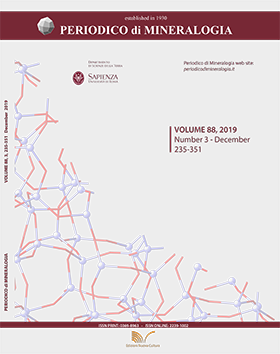Crystal structure of leucophosphite, KFe3+2(PO4)2(OH)·2H2O, from the Jocão pegmatite, Minas Gerais, Brazil
DOI:
https://doi.org/10.2451/2019PM865Keywords:
leucophosphite, crystal structure, single-crystal X-ray diffraction, hydrogen bonding, Jocão pegmatite, Minas Gerais, BrazilAbstract
The crystal structure of leucophosphite, KFe3+2(PO4)2(OH)·2H2O, was fully characterized using single-crystal X-ray data, collected on a crystal from the Jocão pegmatite, Minas Gerais, Brazil. This crystal belongs to the same fragment accurately analysed by electron microprobe. The refinement was carried out in the P21/n space group and unit-cell with a = 9.7734(3) Å, b = 9.6606(2)Å, c = 9.7429(5)Å, β = 102.447(5) ° and V = 898.27(6) Å3 for Z = 4. The known crystal-structure, based on tetramers of octahedrally coordinated sites connected by the (PO4) tetrahedra in a complex tridimensional framework with K atoms located in channels aligned along b axis, is confirmed. Difference Fourier map allowed to unambiguously locate the hydrogen positions that were refined at the final steps of the crystal structure anisotropic refinement leading to an R index of 2.12%. 162 parameters were refined on the basis of 2406 observed (I>3σ(I))reflections. The H-bonding scheme in the structure of leucophosphite is now fully defined. One hydroxyl group and two H2O groups are exhaustively described. OH group has donor-acceptor distance of 2.96 Å and D-H…A 172˚. H2O groups show donor-acceptor distances less than 2.9 Å whereas angles D-H…A are 161-176 ˚ and 162-176 ˚ for OW10 and OW11 respectively. The OW11 atom behaves twice as donor (with H111 and H112) and twice as acceptor (with H91 and H101), results in a distorted tetrahedron with OH9, OW10, O6, and O4. A very good agreement against microprobe chemical analysis was found, also confirmed by bond valence calculation showing expected values for all the atomic sites.


